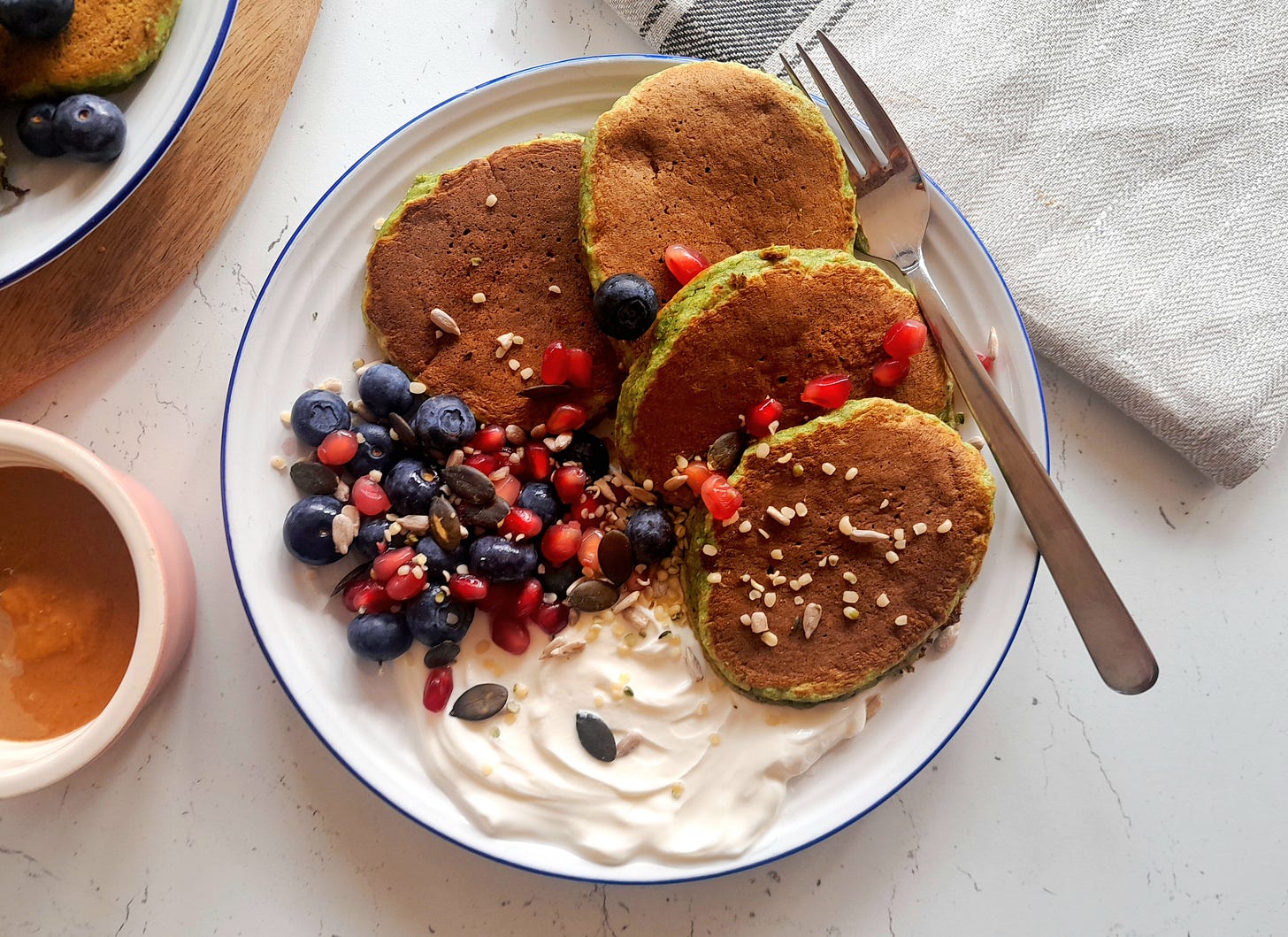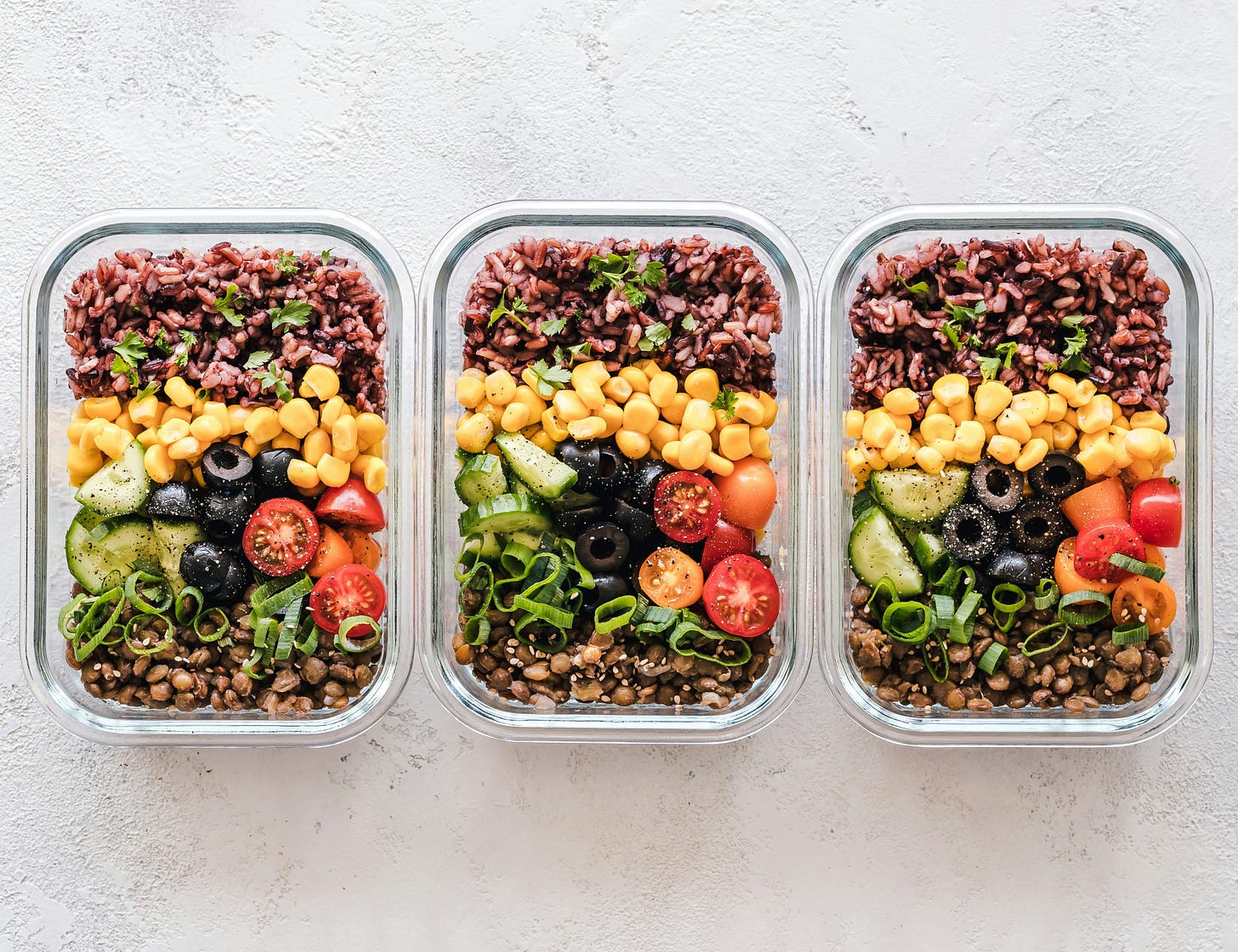The first signs of perimenopause.
Do you know the symptoms to look out for? Tips for diversifying your diet, plus Simple Spinach Pancakes.
Hooray for the first signs of spring — daylight at 5pm, blossoms appearing on trees and groups of daffodils shooting up! That new season feeling has inspired me to try and make Midlife Bites even more useful for you and I’d love to start introducing more recipe content. Do you feel confused about what to eat to support your health in perimenopause? Do you get overwhelmed trying to think of meal ideas that are simple, quick and will also add variety to your diet? How would it feel to have healthy, balanced meals planned for you? And to know that these nutritionist-designed meals will provide everything you need to support you through perimenopause, as well as tasting delicious? I’d love if you could let me know via this poll:
On the topic of ‘first signs’, this month’s edition of Midlife Bites explores oestrogen’s quieter teammate, progesterone and discusses how and why a drop in this hormone is the most common reason for the first signs and symptoms of perimenopause. When it comes to eating to support our overall health, we know that diversity is so important as the variety of nutrients this provides helps support everything from metabolism, hormones and mood to reducing the risk of disease. So this month, I share three tips for making your diet more diverse.
With pancake day just around the corner (one of my favourite days of the year btw!), this edition’s recipe is Simple Spinach Pancakes. The quinoa flakes and chia seeds add protein, fibre and healthy fats — plus the addition of spinach is just another chance to eat more veg. These pancakes freeze really well so are great to batch cook ahead of time — and they make great snacks for kids!
For paid subscribers, I dive into whether a plant-based diet is the answer to easing symptoms in perimenopause — what exactly is it, what are the benefits and is there anything to be mindful of with plant-based eating? Plus, I share the supplements to consider if this is the approach you choose.
As always, I’d love to hear from you if you’re interested in working together, or if you have any questions or comments — either hit reply or book a free 1-to-1 chat.
Progesterone & early signs of perimenopause
When we talk about perimenopause and menopause, oestrogen often takes centre stage but its teammate progesterone also plays a significant part. Progesterone is primarily produced by the ovaries after ovulation and helps prepare the womb for a potential pregnancy. But it also has other functions such as regulating mood, helping with focus, regulating sleep, supporting bone health, and influencing overall brain function. Commonly known as the relaxing hormone, progesterone stimulates your brain to produce a neurotransmitter called gamma-aminobutyric acid (GABA), which has a calming effect, leading to reduced anxiety, stress relief and better sleep.
The first signs of perimenopause are usually driven by a drop in progesterone. Why does it drop first? Ovulation starts to become more irregular in your late 30s to 40s and since progesterone is made after ovulation, less ovulation means lower progesterone. Combine this with fluctuating oestrogen and you end up with a low progesterone-to-oestrogen balance, leading to early symptoms. This first stage often manifests as a more sporadic monthly cycle — periods may get heavier, longer, cycles may be shorter or less regular. Sleep may also be affected by this drop in progesterone, leading to difficulties getting to sleep, waking up more in the night, less deep sleep and reduced quality sleep. With falling progesterone leading to less GABA, we’re also likely to feel more anxious, irritable and have low mood. The imbalance between progesterone and oestrogen may result in new (or worsened) hayfever-like symptoms due to a build-up of histamine. If you’ve noticed allergy symptoms getting worse, or an increase in bloating, rashes, brain fog or headaches, find out more about histamine, how it may be impacting your symptoms and what you can do to manage it.
This shift in progesterone levels can also make it harder to cope with stress and vice versa. The precursor to progesterone is pregnenalone — a ‘raw material’ created by the body from cholesterol to make many hormones, including progesterone, oestrogen, testosterone and the the stress hormone cortisol. When you’re faced with ongoing stress, your body may use pregnenolone to make more cortisol to keep up with demand and to prioritise survival, leaving progesterone levels depleted. As progesterone is already declining, the extra stress makes the drop even more significant. And as we know, less progesterone means less GABA, making stress harder to handle. Midlife can be full of stressors — from juggling family life and work to financial pressures as well as the stress of physical changes — so finding ways to manage stress matters now more than ever before.
So how can we help to support progesterone and ease these early perimenopause symptoms? Try to eat to support blood sugar balance; incorporate foods containing omega-3 fatty acids (oily fish, walnuts), zinc (seafood, pumpkin seeds, nuts), magnesium (green leafy veg, wholegrains, dark chocolate) and vitamins B6 (sunflower seeds, fish, turkey) and C (kiwis, broccoli, yellow peppers); find ways to reduce stress; get enough sleep; and if you’re finding it difficult to cope with your symptoms, don’t hesitate to speak to your GP to discuss your options.
If you would like to learn more about how to support your perimenopause symptoms through diet and lifestyle, please do get in touch, I’d love to chat!
To diversify your diet
No matter whether you subscribe to 5-a-day, 7-a-day or 30 plants a week, it’s the variety in your diet that is key to good overall health. Not only does a diversity of fresh produce provide the body with a wealth of phytonutrients and antioxidants which are crucial for the health of our cells, but they also contain fibre which helps to balance blood sugar levels and keep our bowels moving regularly, both of which are key to hormonal balance in perimenopause. The number of different plants we eat also has a significant impact on the diversity of bacteria in our gut as they love a variety of fibres to feed off. Having a diverse microbiome will help support everything from your metabolism, hormones and mood to reducing the risk of disease and helping you to withstand the challenges of daily life. In perimenopause, as your hormones decrease, so does your gut microbiome diversity, so eating a wide range of plants is key. Here are three tips to help add more variety to your meals:
Keep a jar of mixed seeds. Mix together a range of different seeds and keep it on your kitchen worktop or table to remind you to sprinkle on every meal. I like: pumpkin seeds, sunflower seeds, chia seeds, flaxseeds, shelled hemp seeds and sesame seeds.
Try a different wholegrain. Most of us eat too few wholegrains — 95% of adults don’t eat enough wholegrains and nearly one in three of us get none at all. Experimenting with different varieties is a great way to add diversity: try quinoa instead of rice or add to porridge; choose buckwheat flakes instead of oats; add spelt or barley to soups; try wild rice or pseudo-grains such as amaranth and millet.
Add a new veg to your trolley. It’s so easy to fall into the routine of having the same vegetables with your lunch or dinner (salads with lettuce, tomatoes and cucumber; meals with broccoli and peas?). So try to add more diversity by adding a new vegetable to your shopping each week. How about: Swiss chard, artichoke, radish, asparagus, aubergine, purple sprouting broccoli, or Brussels sprouts?
If you’re interested in working with me on a 1-to-1 basis, why not book a complimentary chat to find out more about how I can support you through perimenopause. And if you’re on Instagram, come and say hi.
Simple Spinach Pancakes
Makes: 16 | Time: 20 minutes
I could eat pancakes for breakfast, lunch and dinner. They’re such a great way to pack in extra protein and veg into a meal. I’ll often blend silken tofu or cottage cheese into the mix; or swap wholemeal flour for almond flour; and add in grated apple and carrots, or spinach or courgette. This recipe includes quinoa flakes to add more protein and fibre, but you could also just use regular oats. The chia seeds also provide protein, fibre and healthy fats. I served them with extra thick Greek yoghurt, seeds and berries, but you could also enjoy a savoury combo of a couple of fried or poached eggs, some sliced avo and smoked salmon. Store any leftovers in the freezer and defrost in the toaster when you’re in need of a quick breakfast or snack.
INGREDIENTS
2 large handfuls of spinach
1 banana, mashed
2 eggs, beaten
150g wholemeal spelt flour
50g quinoa flakes, (or oats)
2 tablespoons chia seeds
3 teaspoons baking powder
240ml milk
to serve:
dollop of Greek yoghurt
handful of blueberries & pomegranate seeds
sprinkle of mixed seeds
drizzle of nut butter
METHOD
Place the spinach in a colander and pour over boiling water to wilt. Set aside to cool.
In a large bowl, beat together the banana and eggs.
Add the flour, quinoa flakes (or oats), chia seeds and baking powder and mix to combine.
Squeeze the spinach to remove as much water as possible. Place in a blender with the milk and blitz until smooth.
Pour the spinach mixture over the dry ingredients and mix until well combined.
Place a frying pan over medium to high heat, then add tablespoons of the pancake mixture to the pan. Cook for a few minutes, then flip to cook the other side. Repeat until all of the mixture is used.
Serve the pancakes with 4 on a plate, a dollop of Greek yoghurt, berries, a sprinkle of seeds and a drizzle of nut butter.
Can a plant-based diet help in perimenopause?
There’s no single best way to eat, but we do know that eating more plants, more of the time, may have significant health benefits. But what does a plant-based way of eating even mean and will it really improve your symptoms in perimenopause?
Keep reading with a 7-day free trial
Subscribe to Midlife Bites to keep reading this post and get 7 days of free access to the full post archives.












